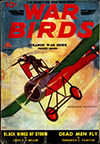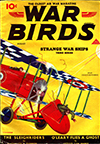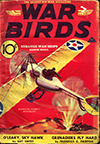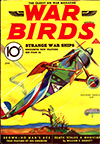Strange War Ships: Deperdussin Monoplane
FOR FOUR successive months in 1933, War Birds ran a series of covers featuring “Strange War Planes.”—those freak planes that were used during the First World War. The covers were by Eugene M. Frandzen—known here for the covers he did for Sky Fighters from its first issue in 1932 until he moved on from the pulps in 1939. The Final freaky ship in the series was the Deperdussin Monoplane!
Strange War Ships:
Deperdussin Monoplane

 BEFORE synchronization of machine gun fire was perfected, many strange ways were devised to fire in the direction of flight. The Deperdussin Monoplane, with machine gunner mounted atop the wing was one of these. A rudder attachment kept the gun from whipping from side to side. The ship was armoured and a superstructure of steel pipes formed the gunner’s cockpit. A gunner on this ship had to have a sense of balance equal to an acrobat to be accurate with the gun.
BEFORE synchronization of machine gun fire was perfected, many strange ways were devised to fire in the direction of flight. The Deperdussin Monoplane, with machine gunner mounted atop the wing was one of these. A rudder attachment kept the gun from whipping from side to side. The ship was armoured and a superstructure of steel pipes formed the gunner’s cockpit. A gunner on this ship had to have a sense of balance equal to an acrobat to be accurate with the gun.
The Deperdussin was the forerunner of the 5pad. This ship and the single place were used extensively on the Russian front. Germany, at that time, considered these ships the most dangerous used by the allies. The single seater had the phenomenal speed of 131 m.p.h. when stripped.
LENGTH . . . . . . . . . . . . . . . . . . . . . . . . . . . . . . . . . . . . .24′
SPAN . . . . . . . . . . . . . . . . . . . . . . . . . . . . . . . . . . . . . 36′3â€
AREA . . . . . . . . . . . . . . . . . . . . . . . . . . . . . . . . . . 226 sq.ft.
WEIGHT . . . . . . . . . . . . . . . . . . . . . . . . . . . . . . . . .1050 lbs.
MOTOR . . . . . . . . . . . . . . . . . . . . . . . . . . . . .80 h.p. Gnome
SPEED . . . . . . . . . . . . . . . . . . . . . . . . . . . . . . . . .105 m.p.h.
CLIMB . . . . . . . . . . . . . . . . . . . . . . . . . . . . . .247 ft.per min.


Strange War Ships: Deperdussin Monoplane • War Birds, August 1933
by Eugene M. Frandzen
Strange War Ships: Spad Tractor-Pusher
FOR FOUR successive months in 1933, War Birds ran a series of covers featuring “Strange War Planes.”—those freak planes that were used during the First World War. The covers were by Eugene M. Frandzen—known here for the covers he did for Sky Fighters from its first issue in 1932 until he moved on from the pulps in 1939. The third in the series was the Spad Tractor-Pusher.
Strange War Ships:
Spad Tractor-Pusher

 THIS was one of the freakiest ships of the war, presenting the diverting 5pectacie of pilot and gunner in the same ship but separated by the whirling propeller.
THIS was one of the freakiest ships of the war, presenting the diverting 5pectacie of pilot and gunner in the same ship but separated by the whirling propeller.
Before the days of the front fire fokker engineers and pilots were dreaming of a device which would enable them to fire a machine gun in the direction of flight. The existing pushers permitted this but they were being replaced by tractors with their higher performance. The pilot wanted to take his front fire gun with him from the pusher to the tractor, but synchronization was unheard of then.
The result was as pictured on the cover and in this sketch. Sechereau, the designer, took the standard Spad tractor with 150 h.p. hisso and suspended a nacelle before the prop by a pair of members which formed part of the undercarriage.
The ship flew and was being considered for military use when the Fokker Eindecker came out. Naturally this type of ship became obsolete immediately.


Strange War Ships: Spad Tractor-Pusher • War Birds, August 1933
by Eugene M. Frandzen
What is next month’s strange ship? Check back again for pictures and complete data on another freak ship of the war!
Strange War Ships: Maxmilian Schmitt Monoplane
FOR FOUR successive months in 1933, War Birds ran a series of covers featuring “Strange War Planes.”—those freak planes that were used during the First World War. The covers were by Eugene M. Frandzen—known here for the covers he did for Sky Fighters from its first issue in 1932 until he moved on from the pulps in 1939. The second issue featured the Maxmilian Schmitt Monoplane.
Strange War Ships:
Maxmilian Schmitt Monoplane
 THE U.S. Army, after extensive tests, ordered this odd looking ship for service. At that time it was considered one of the fastest and safest of ships. It was to be partially armored. This feature anticipated Germany’s armoring of ships by several years.
THE U.S. Army, after extensive tests, ordered this odd looking ship for service. At that time it was considered one of the fastest and safest of ships. It was to be partially armored. This feature anticipated Germany’s armoring of ships by several years.
The wings were supported by cables both top and bottom. The upper cables hanging from a pyramid of four steel tubes gave it an odd appearance. The most radical part of the design was the long rectangular section upon which was the tail planes. Another advanced feature of this ship was tubular steel construction of the landing gear.
It was powered by a 50 h.p. Gnome motor, had a top speed of 65 m.p.h. and could climb 50 feet per minute. It had a span of 25 feet. It’s length was 18 feet. The lifting surface was only 150 square feet, The weight was 600 pounds.


Strange War Ships: Maxmilian Schmitt Monoplane • War Birds, July 1933
by Eugene M. Frandzen
What is next month’s strange ship? Check back again for pictures and complete data on another freak ship of the war!
Strange War Ships: Nieuport Triplane
FOR FOUR successive months in 1933, War Birds ran a series of covers featuring “Strange War Planes.”—those freak planes that were used during the First World War. The covers were by Eugene M. Frandzen—known here for the covers he did for Sky Fighters from its first issue in 1932 until he moved on from the pulps in 1939. First up we have the Nieuport Triplane of 1918!
Strange War Ships:
The Nieuport Triplane of 1918

 DESPITE the unusual appearance op this month’s cover ship, the designers were not trying to be funny. Triplane design was based on the pact that the use of three planes would permit a narrower chord and hence greater visibility for the pilot; increased maneuveribility; shortening of span and reduction of length without loss of lifting surface.
DESPITE the unusual appearance op this month’s cover ship, the designers were not trying to be funny. Triplane design was based on the pact that the use of three planes would permit a narrower chord and hence greater visibility for the pilot; increased maneuveribility; shortening of span and reduction of length without loss of lifting surface.
The “tripes” had the fatal weakness of shedding their linen on the upper wings and breaking up in the air. Sopwith, of England, produced the first successful tripe followed soon by Albatross and Fokker tripes. Nieuport engineers conceived the idea of staggering the wings like stair-steps. The result is pictured here, it was undergoing tests as the war closed. It was powered by a 110 h.p Le Rhone and had a top speed of 121 m.p.h., a span of 26 feet and length of 18 feet.


Strange War Ships: Nieuport Triplane 1918 • War Birds, June 1933
by Eugene M. Frandzen
Item of note: the cover image has apparently been reversed from the way it was painted as Frandzen’s signature is backwards on the ground under the tail of the Nieuport Triplane.

What is next month’s strange ship? Check back again for pictures and complete data on another freak ship of the war!

 BEFORE synchronization of machine gun fire was perfected, many strange ways were devised to fire in the direction of flight. The Deperdussin Monoplane, with machine gunner mounted atop the wing was one of these. A rudder attachment kept the gun from whipping from side to side. The ship was armoured and a superstructure of steel pipes formed the gunner’s cockpit. A gunner on this ship had to have a sense of balance equal to an acrobat to be accurate with the gun.
BEFORE synchronization of machine gun fire was perfected, many strange ways were devised to fire in the direction of flight. The Deperdussin Monoplane, with machine gunner mounted atop the wing was one of these. A rudder attachment kept the gun from whipping from side to side. The ship was armoured and a superstructure of steel pipes formed the gunner’s cockpit. A gunner on this ship had to have a sense of balance equal to an acrobat to be accurate with the gun.

















